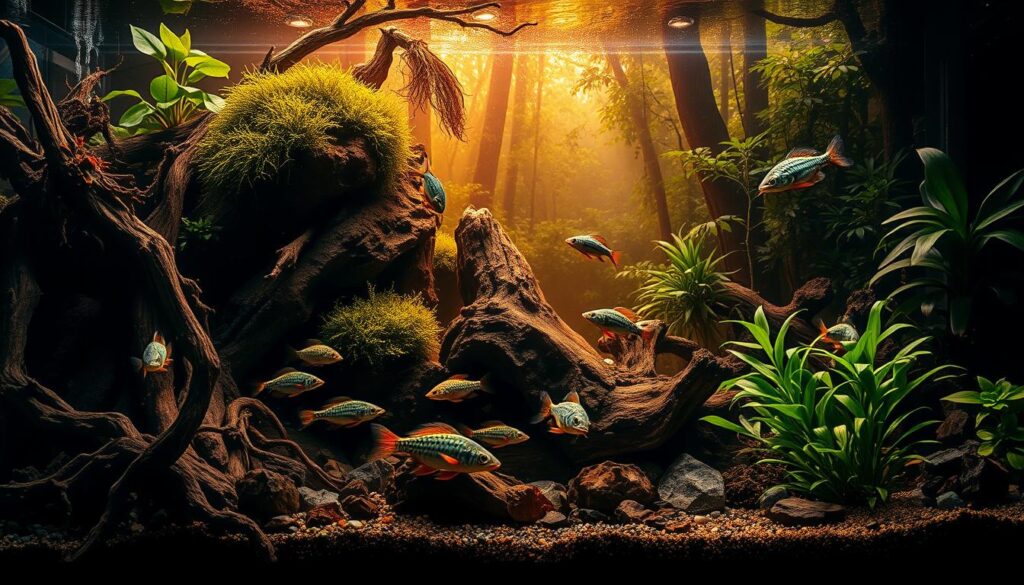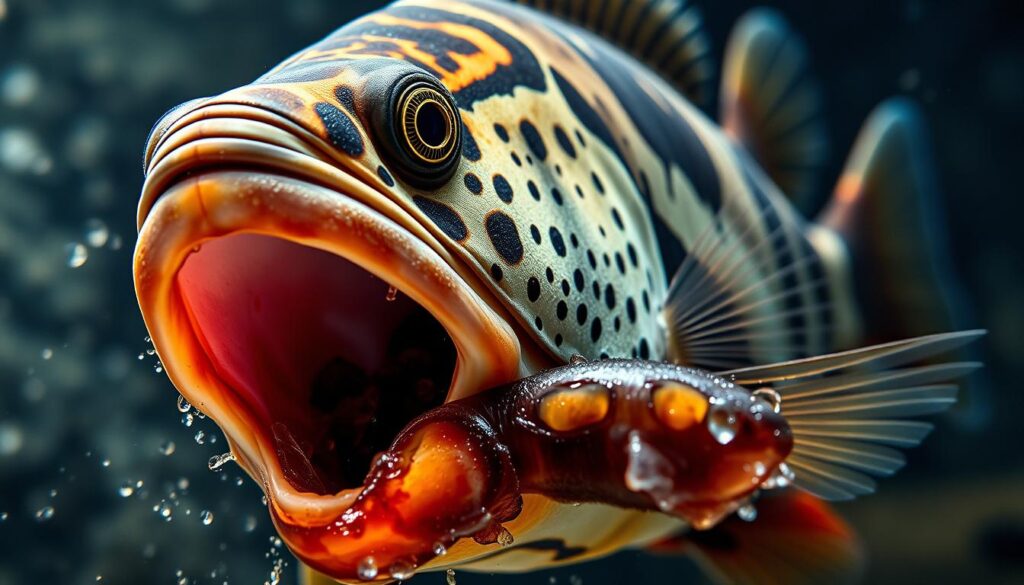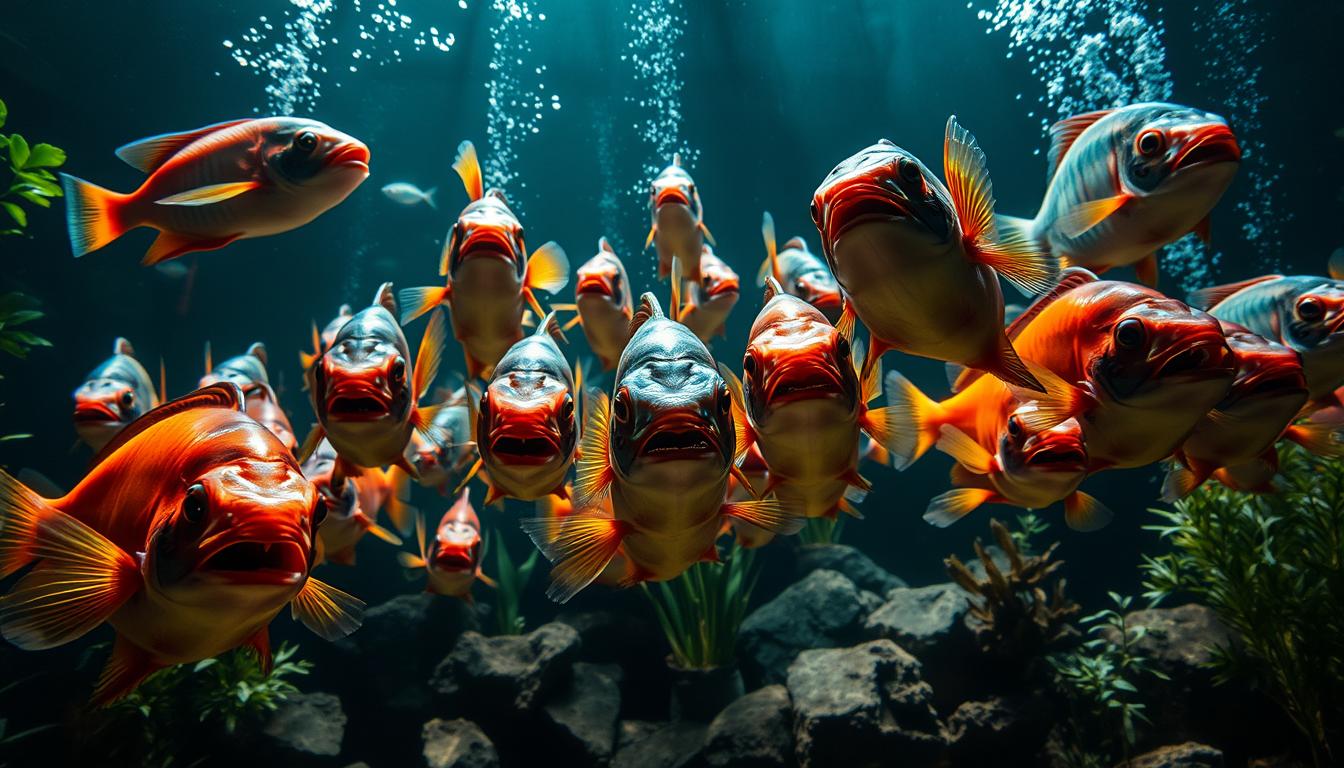Are you ready to dive into the world of aggressive aquarium fish? These feisty creatures can add a thrilling dimension to your tank, but they require special care!
Many popular aquatic pets are known for their bold behavior, including tetras, Oscars, cichlids, and Jack Dempsey. To keep these fin-tastic friends happy and healthy, you’ll need to understand their behavior and choose the right tank mates.
We’ll explore what you need to know before bringing home your new aggressive fish species, from aggressive fish care tips to creating a harmonious underwater world!
Key Takeaways
- Understand the behavior of aggressive fish species
- Choose the right tank mates for a harmonious tank
- Learn essential care tips for your new finned friends
- Create a thriving environment for your aquatic pets
- Discover the best practices for introducing new fish to your tank
Understanding Aggressive Fish Behavior in Aquariums
Aggression in fish is not just about being mean; it’s often about survival and territory. When setting up an aquarium, understanding why your fish are aggressive is crucial for creating a harmonious environment.
Natural Instincts and Territorial Behavior
Fish aggression is primarily driven by natural instincts, such as defending territory or competing for resources. In the wild, fish establish territories to ensure access to food, shelter, and potential mates. When kept in aquariums, these instincts remain, and fish may become aggressive when they feel their territory is threatened or when resources are scarce. For instance, some species are naturally more territorial and will fiercely defend their area against other fish.
Different Types of Aggression in Fish
There are several types of aggression exhibited by fish in aquariums, including territorial aggression, predatory aggression, and competitive aggression. Understanding these different types can help you manage your aquarium more effectively.
| Type of Aggression | Description | Example |
|---|---|---|
| Territorial Aggression | Defending a specific area or territory | Cichlids defending their nesting site |
| Predatory Aggression | Hunting or chasing other fish for food | Oscars chasing smaller fish |
| Competitive Aggression | Competing for resources like food or mates | Bettas competing for food at the surface |
By recognizing the reasons behind your fish’s aggressive behavior, you can take steps to mitigate conflicts and create a more peaceful aquarium environment. This might involve rearranging decorations to reduce territorial disputes or selecting tank mates that are compatible and less likely to trigger aggression.
Top Aggressive Aquarium Fish Species for Hobbyists
Dive into the fascinating world of aggressive aquarium fish and discover the top species that’ll make a splash in your tank! If you’re an aquarium enthusiast looking to add some excitement to your underwater world, aggressive fish can be a thrilling choice. However, it’s crucial to know which species are best suited for your experience level and tank conditions.
Cichlids: African and South American Varieties
Cichlids are among the most popular aggressive fish for aquariums, with varieties like the African Cichlids and South American Cichlids being top choices. The Midas Cichlid and Pike Cichlid are known for their bold personalities and vibrant colors. These fish require spacious tanks with plenty of hiding spots to reduce aggression.
Bettas and Other Labyrinth Fish
Betta fish, also known as Siamese fighting fish, are a favorite among hobbyists due to their elaborate fins and fearless attitude. Other labyrinth fish like the Paradise Fish are also known for their aggressive behavior, especially towards fish of similar appearance or finnage.
Predatory Species: Oscars, Jack Dempseys, and Red Devils
For those looking for the ultimate predators, Oscars, Jack Dempseys, and Red Devils are top contenders. These fish are known for their large size and voracious appetites. They require large tanks with robust filtration systems to manage the waste they produce.
Read Also Betta Fish Spitting Food? Causes & Fixes
Beginner-Friendly Aggressive Species
If you’re new to keeping aggressive fish, starting with species like the Convict Cichlid or Zebra Cichlid can be a good introduction. These fish are relatively hardy and can tolerate minor fluctuations in water conditions, making them more forgiving for beginners.
When choosing aggressive fish for your aquarium, it’s essential to research their specific needs and temperaments to ensure compatibility and a harmonious environment. With the right selection and care, your tank can become a thriving ecosystem that showcases the beauty and vigor of these remarkable fish.
Essential Tank Requirements for Aggressive Fish
Creating a thriving environment for your aggressive aquarium fish requires careful planning and attention to detail. Aggressive fish have specific needs that must be met to reduce stress and promote a healthy aquarium.
Appropriate Tank Size and Dimensions
When it comes to keeping aggressive fish in aquarium, a spacious tank is crucial. A larger tank provides ample space for your fish to establish territories and explore without feeling threatened by other fish. For most aggressive species, a minimum tank size of 55 gallons is recommended.
However, some species, like Oscars or Jack Dempseys, may require even larger tanks – think 75 gallons or more! The tank’s dimensions are also important; a longer tank with a larger surface area can help reduce aggression by providing more space for fish to swim and establish their territories.
Ideal Water Parameters and Conditions
Aggressive fish often come from diverse environments, so it’s essential to research the specific water requirements for your species. Generally, most aggressive fish thrive in well-oxygenated water with stable parameters. Regular water changes and a high-quality filtration system are vital to maintaining optimal water conditions.
For many aggressive species, a pH range of 6.5-8.5 and water temperatures between 76-82°F (24-28°C) are suitable. However, some species may have more specific requirements, so be sure to check the needs of your particular fish.
Read Also 75 Gallon Aquarium Weight: Full Guide (Empty, Filled & With Stand)
Creating Territories and Hiding Spots
Providing hiding spots and visual barriers is crucial for reducing aggression in your tank. You can achieve this by incorporating various decorations, such as plants, rocks, driftwood, and other ornaments. These elements help create separate territories within the tank, giving each fish a sense of security and reducing conflicts.
When designing your tank, consider the natural habitats of your aggressive fish and try to replicate them. For example, cichlids often appreciate rocky formations, while betta fish may prefer dense vegetation.

By focusing on these essential tank requirements, you can create a thriving environment for your aggressive fish, reducing stress and promoting a healthy aquarium. With the right setup, you’ll be well on your way to enjoying the fascinating world of aggressive aquarium fish care!
Setting Up Your Aggressive Fish Aquarium
Now that we’ve explored the fascinating world of aggressive aquarium fish, it’s time to dive into setting up their home. Creating a thriving environment for these finned friends requires careful planning, the right equipment, and a few insider tips!
Essential Equipment and Filtration Systems
A robust filtration system is crucial for maintaining good water quality, which is vital for reducing aggression in fish. We recommend a high-quality canister filter or a sump system that can handle the biological load of your aquarium. Regular water changes and proper filtration will help keep your fish healthy and stress-free.
When choosing equipment, consider the size of your tank and the type of fish you’re keeping. For example, larger cichlids require more powerful filtration to handle their waste output. Don’t forget to include a heater, as many aggressive fish species prefer warmer waters!

Decorations and Aquascaping Strategies
Decorations and aquascaping play a crucial role in creating territories and hiding spots for your aggressive fish. Use a mix of rocks, driftwood, and plants to create a natural environment that reduces stress and aggression. Consider using plants like Anubias or Java Fern, which are hardy and can withstand the occasional nip from your fish.
Read Also 75 Gallon Marineland Aquarium Review: Size, Features & Setup Guide
When designing your aquascape, think about creating separate territories and visual barriers to reduce conflict between fish. You can achieve this by using tall decorations or by creating caves and crevices.
| Decoration Type | Purpose | Examples |
|---|---|---|
| Rocks and Boulders | Create territories and hiding spots | Large rocks, boulders, and stone formations |
| Driftwood | Provide hiding places and visual barriers | Manzanita, driftwood roots, and branches |
| Plants | Reduce stress and provide food | Anubias, Java Fern, and Amazon Swords |
Maintenance Schedule and Considerations
Regular maintenance is key to keeping your aggressive fish healthy and thriving. Perform regular water changes (about 10-20% every week), clean your filtration system, and monitor water parameters to ensure a stable environment.
Keep an eye on your fish’s behavior and adjust your maintenance schedule accordingly. For example, if you notice increased aggression during feeding time, consider using a feeding ring or separate feeding areas to reduce competition.
Compatible Tank Mates for Aggressive Fish
Choosing the right tank mates for your aggressive fish can be a daunting task, but with the right guidance, you can create a harmonious aquarium. Aggressive fish can be challenging to pair with other species, but understanding their compatibility is key to a thriving community tank.
Selecting Fish That Can Coexist
When selecting tank mates for your aggressive fish, it’s crucial to choose species that can defend themselves or are similarly aggressive. For example, some Cichlids can be kept with other Cichlids or robust species like Plecos or Silver Dollars. Researching the specific needs and temperaments of the fish you’re interested in keeping together is vital.
Some species, like Oscars and Jack Dempseys, can be kept with similar-sized fish, while others, like Bettas, are best kept alone due to their highly aggressive nature. Understanding the adult size and territorial requirements of your fish will help you make informed decisions about tank mates.
| Aggressive Fish Species | Compatible Tank Mates | Species to Avoid |
|---|---|---|
| Oscars | Silver Dollars, Large Cichlids | Small Tetras, Guppies |
| Jack Dempseys | Convict Cichlids, Severums | Fin-nippers, Small peaceful fish |
| Bettas | Best kept alone | Other Bettas, Fin-nippers |
Species to Absolutely Avoid
Some fish are best avoided when keeping aggressive species. Fin-nippers, slow-moving fish, or those with long, flowing fins are often targeted by aggressive tank mates. For instance, Guppies and Angelfish can be easy prey for more aggressive fish. Avoid mixing these species unless you’re experienced and prepared for potential conflicts.

Creating Community Tanks with Aggressive Species
Creating a community tank with aggressive species requires careful planning. Start with a large tank (at least 55 gallons) to provide ample space and reduce territorial conflicts. Incorporate plenty of hiding places and visual barriers to help reduce aggression. Monitor your fish closely, and be prepared to separate them if conflicts arise.
By carefully selecting compatible tank mates and designing your tank with aggression in mind, you can enjoy a vibrant and dynamic aquarium even with aggressive fish species.
Feeding and Nutrition for Aggressive Aquarium Fish
When it comes to feeding aggressive aquarium fish, understanding their dietary requirements is crucial for their well-being and your success as an aquarist. Aggressive fish, by their nature, have high energy levels and often require a diet rich in proteins to maintain their health and vitality.
Dietary Requirements and Feeding Schedules
Aggressive fish need a balanced diet that includes a mix of proteins, fats, and carbohydrates. A varied diet helps in reducing nutritional deficiencies and keeps the fish active and healthy. For most aggressive species, feeding 2-3 times a day is recommended, but this can vary based on the species, size, and age of the fish.
It’s essential to research the specific dietary needs of your fish. For example, carnivorous fish like Oscars and Jack Dempseys require a diet high in meaty foods, whereas some omnivorous species can thrive on a more varied diet that includes both meaty and vegetable-based foods.
Live, Frozen, and Prepared Foods
Providing a mix of live, frozen, and prepared foods can help meet the nutritional needs of aggressive fish. Live foods like brine shrimp and feeder fish can stimulate natural hunting behavior, while frozen foods offer a convenient alternative that’s rich in nutrients. Prepared foods, such as high-quality commercial pellets or flakes, can be a staple in their diet, ensuring they receive all necessary nutrients.

Feeding Techniques to Reduce Aggression
Feeding techniques can play a significant role in reducing aggression among tank mates. Using multiple feeding stations can help distribute the fish during feeding, reducing competition and aggression. It’s also beneficial to feed them at the surface and bottom of the tank to ensure all fish get a chance to eat.
By understanding and implementing the right feeding strategies, you can significantly reduce aggression and promote a healthier environment for your aggressive aquarium fish.
Managing and Reducing Aggressive Behavior
If you’re struggling with aggressive fish behavior, you’re not alone – let’s explore some practical tips to help you minimize conflict! Aggressive behavior in aquarium fish can be a real challenge, but with the right strategies, you can create a more harmonious environment.
Environmental Modifications to Minimize Conflict
One of the most effective ways to reduce aggression is by modifying your tank’s environment. Increasing tank size and complexity can help distribute aggression and provide fish with places to hide. Here are some key modifications to consider:
- Add more plants and decorations to create hiding spots and visual barriers!
- Rearrange tank decor periodically to disrupt established territories and reduce aggression!
- Ensure optimal water conditions by maintaining proper pH, ammonia, and nitrite levels!
Behavioral Training Techniques
While environmental changes are crucial, behavioral training can also play a significant role in managing aggression. You can try the following techniques:
- Feed your fish in a way that reduces competition – try feeding them in separate areas or at different times!
- Provide a varied diet to keep your fish engaged and stimulated, reducing stress and aggression!
- Observe your fish regularly to identify and address any signs of stress or aggression early on!
When to Separate Problem Fish
Despite your best efforts, some fish may still exhibit aggressive behavior that threatens the harmony of your tank. In such cases, separating problem fish may be necessary. Consider the following:
- If a fish is consistently bullying others or being bullied, it may be best to separate it!
- Use a separate tank or a divider to isolate aggressive fish and reduce stress on other tank inhabitants!
- Monitor the behavior of the separated fish and adjust your strategy as needed!
By implementing these strategies, you can significantly reduce aggressive behavior in your aquarium and create a more peaceful environment for your fish to thrive!
Common Challenges When Keeping Aggressive Aquarium Fish
Keeping aggressive aquarium fish can be a thrilling experience, but it’s not without its challenges! As an aquarist, you’re likely to face several common issues that can impact the health and well-being of your fish.
Dealing with Excessive Aggression
Excessive aggression is a common problem when keeping aggressive aquarium fish. To manage this, you can try rearranging the tank’s decorations to disrupt territorial behavior or introducing tank mates that can stand up for themselves. However, it’s crucial to monitor the situation closely to prevent injury or stress to your fish.
Health Issues and Disease Prevention
Aggressive fish are often more prone to health issues due to stress and injury. Regular monitoring and maintaining optimal tank conditions can help prevent disease. Ensure you’re providing a balanced diet, and consider quarantining new or injured fish to prevent the spread of disease.
Stress Management and Its Importance
Stress management is critical when keeping aggressive aquarium fish. You can reduce stress by providing plenty of hiding places, maintaining stable water parameters, and avoiding overcrowding. By minimizing stress, you can help promote the overall health and well-being of your fish.
By understanding these common challenges and taking steps to address them, you can create a thriving environment for your aggressive aquarium fish. With the right care and attention, you can enjoy the unique rewards of keeping these fascinating fish.
Conclusion: Is an Aggressive Aquarium Fish Right for You?
As we wrap up our journey into the world of aggressive aquarium fish, you’re now better equipped to make an informed decision about bringing these fascinating creatures into your home. Keeping aggressive fish can be a rewarding experience, but it requires careful consideration and research.
When choosing the right aggressive fish, it’s essential to understand their needs and be prepared to provide the right care. Some aggressive fish species for beginners can thrive in a well-maintained tank with proper tank mates and a balanced environment.
So, is an aggressive aquarium fish right for you? If you’re willing to put in the time and effort to understand their behavior and provide the right conditions, the answer is yes! With the knowledge you’ve gained, you can enjoy the many rewards of keeping these amazing fish.
Ultimately, the decision to keep aggressive aquarium fish should be based on your ability to provide the right care and attention. We hope this guide has helped you make an informed decision and inspired you to create a thriving aquarium that brings joy and excitement to your life.

